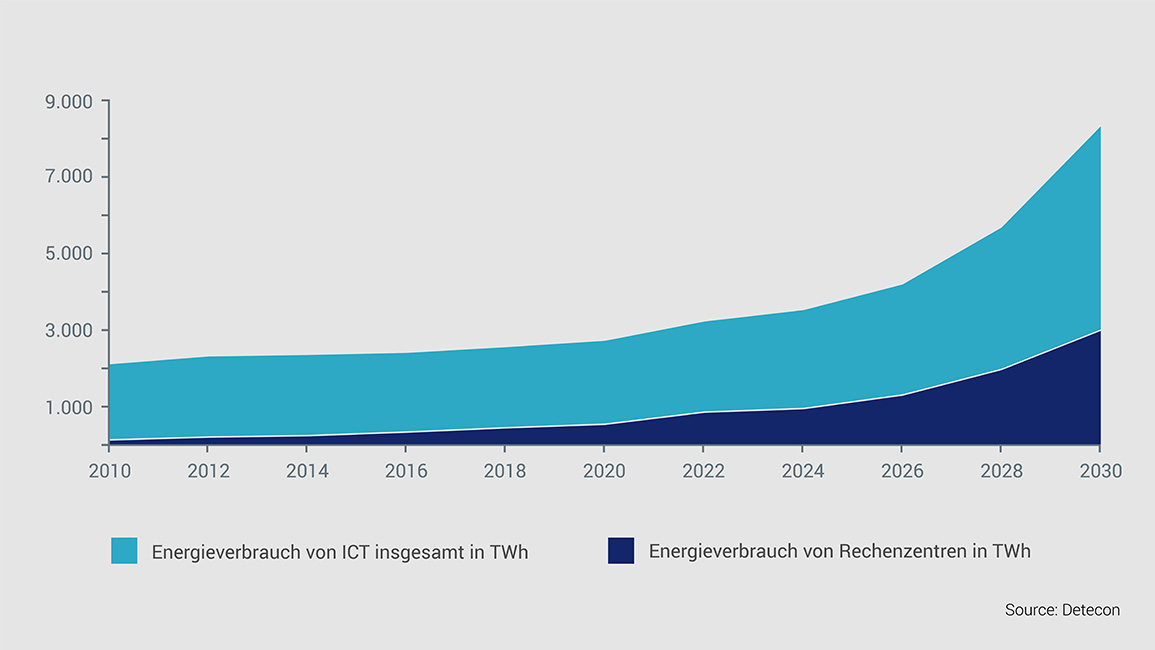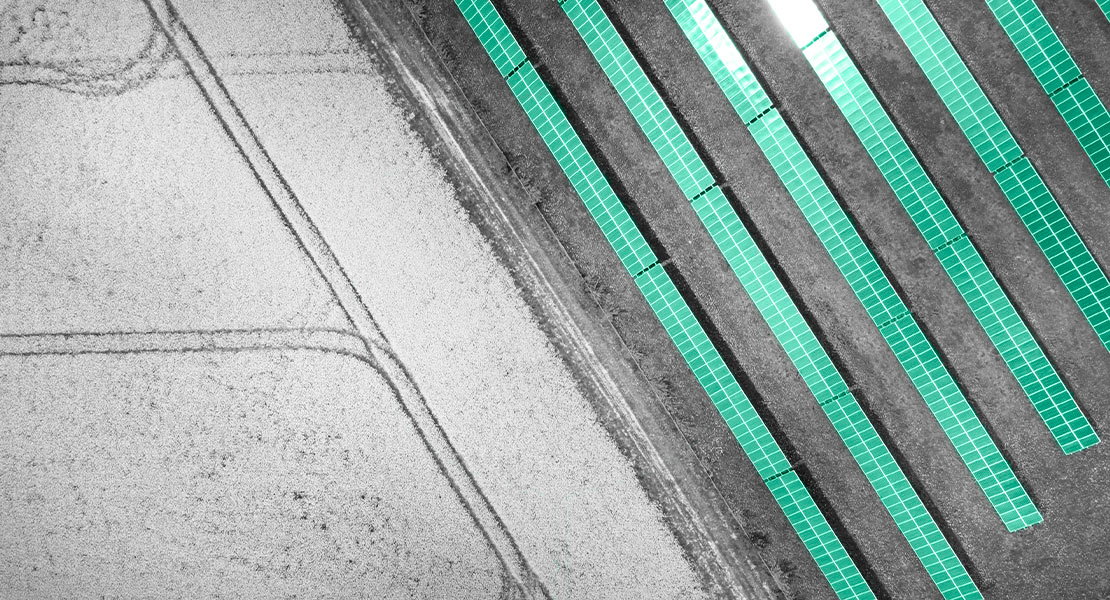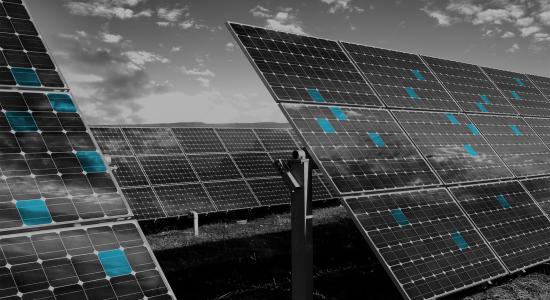According to the Federal Environment Agency, emissions of carbon dioxide equivalents in Germany amounted to roughly 739 million metric tons in 2020. The adoption of the Paris Climate Agreement, which aims to limit global warming to well below two degrees, has created a need for action by governments and all sectors of the business community. The energy industry in particular is at the focus of public debate as it is the largest emitter of greenhouse gases.
Energy utilities are the source of about 30 percent of the CO2 equivalents emitted in Germany. A growing share of these emissions results from the rising importance of IT in this sector (similar to other industries) as evidenced by the climbing energy expenditures for data centers.

But that is not all. Since utilities often operate their own data centers for cost or security reasons or as part of their telecommunications services, they are coming under even more pressure from an unexpected direction. It begins with the commitment of the industry players in the trade association Cloud Infrastructure Service Providers in Europe to achieve climate-neutral operations by 2030. Shedding their data centers, however, is unimaginable for many energy utilities; thanks to the advantages of location, knowledge, and security these centers enjoy (for colocation services, for instance), utilities have determined that the operation of their own data centers is a viable business model for the future. Within the scope of such agreements, companies lease their data center resources to third parties on competitive terms. As they are operators of critical infrastructures, energy utilities benefit from confidence in their security standards and a broadly developed distribution network.
So energy utilities are on the horns of a dilemma. On the one hand, they need ever greater amounts of electricity to drive the digitalization of their business operations; on the other hand, they need to reduce their end energy consumption if they want to maintain their competitiveness as data center operators in the long term — in no small part because of the rising CO2 prices in their core business. The strategic positioning of energy supply companies is thus caught between the conflicting priorities of digitalization and decarbonization.
Green IT could offer a way out of this thorny situation.
Sustainable IT operation with green IT
Green IT concerns the sustainable operation of information and communication technology (ICT). It tracks the entire lifecycle of IT across various strategic levels, from the derivation of measurable goals and benchmarks to the efficient architectural design of server racks to the use of low-consumption hardware components. Since data centers have such high energy demands, their operation is at the especially sharp focus of green IT.
A look at the present data center landscape in the energy industry reveals the immense potential of green IT. Many data centers are outdated or are no longer compliant with current energy efficiency requirements. Thirty percent of the energy in a typical data center can be saved. Along with the reduction of the carbon footprint, significant cost savings can also be realized while maintaining or even increasing performance capacity. The first crucial step is to determine the current status of the data centers, then to use the results of the assessments as the basis for setting strategic goals, and finally to upgrade technology in the centers. Best practices for increasing energy efficiency derived from consulting activities are a readily available source of helpful approaches and recommendations for action for the IT departments of energy utilities.
Waste heat recovery in data centers
Data center operators have even further options to realize enormous savings, especially by taking advantage of waste heat recovery. Wanting to see such potential exploited more quickly, the German government will be offering support totaling €50 million annually between now and 2030 as part of the Energy Efficiency Strategy 2050 (NAPE 2.0). One declared goal is the development and promotion of new or previously little-used waste heat utilization technologies in areas such as the low-temperature waste heat production found in data centers.
Even today, heat recovery technologies offer enormous advantages for energy utilities that operate their own data centers. Approximately 70 percent of the electricity consumed in the data center can theoretically be reused as waste heat. Profitability depends above all on the temperature difference. Since the temperature of the waste heat from air-cooled data centers of about 35 °C is too low for many heat applications, heat pumps represent a good option. Optimally, however, data centers make use of hot water cooling, which eliminates the need for heat pumps. In special cases, the waste heat can be used directly: in swimming pools, greenhouses, or even residential complexes, for instance.
Another prerequisite for the distribution of waste heat is the connection to the local heating and district heating network or directly to consumers. During the construction of new data centers, planners should take into account the necessary infrastructure and the integration of heat consumers at an early stage of development. They must keep in mind, however, that supplying heat to residential complexes is subject to a service guarantee of 30 to 50 years.
Edge-Computing
Edge computing also offers certain opportunities to energy utilities. Edge computing brings data processing closer to the application area, so it is also a prerequisite for the energy-efficient operation of IoT solutions. Among other features, edge makes possible the use of intelligent technology for sensor systems, generation, transformation, and maintenance, areas that come into play in the energy industry as well. Moreover, more localized data processing leads to reduced latency, increased scalability and visibility, heightened productivity and reliability of plant operations, greater cybersecurity, and faster decision-making. Furthermore, some of the obsolete network traffic is eliminated, reducing energy consumption even further. With regard to waste heat utilization specifically, edge computing often has the advantage of ensuring a higher waste heat temperature because of the greater power densities.
An initial prerequisite for the monetization of edge computing, however, is its strategic positioning in line with requirements and an integrated business model. In addition, a holistic analysis of profitability and sustainability with a focus on the targeted use cases should be conducted. Finally, it is important to use durable and energy-efficient hardware and construction design for edge computing, including high power density in the rack, efficient chips, and storage systems without hard drives.
The implementation of all the described solutions described and tapping of the associated savings potential demand a holistic approach that starts with determination of the CO2 footprint and continues by setting a genuinely viable IT strategy and suitable efficiency measures in motion. There must always be keen awareness on the part of all involved parties that each and every step toward these solutions is part of an extraordinarily complex project that requires a high level of expertise and coordination during its realization.









